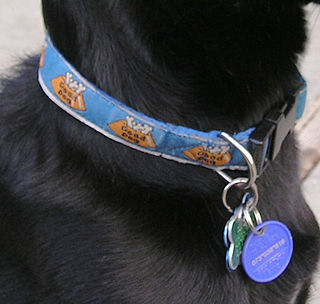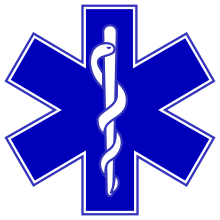
Dog tag is an informal but common term for a specific type of identification tag worn by military personnel. The tags' primary use is for the identification of casualties; they have information about the individual written on them, including identification and essential basic medical information such as blood type and history of inoculations. They often indicate a religious preference as well.

A bracelet is an article of jewellery that is worn around the wrist. Bracelets may serve different uses, such as being worn as an ornament. When worn as ornaments, bracelets may have a supportive function to hold other items of decoration, such as charms. Medical and identity information are marked on some bracelets, such as allergy bracelets, hospital patient-identification tags, and bracelet tags for newborn babies. Bracelets may be worn to signify a certain phenomenon, such as breast cancer awareness, or for religious/cultural purposes.

A medical tattoo is a tattoo used to treat a condition, communicate medical information, or mark a body location for treatment. People may get a paramedical tattoo to conceal a condition or the effects of treatment, such as creating the appearance of an areola after breast reconstruction, or a cover-up tattoo to disguise the area in an artistic way.

A microchip implant is an identifying integrated circuit placed under the skin of an animal. The chip, about the size of a large grain of rice, uses passive radio-frequency identification (RFID) technology, and is also known as a PIT tag. Standard pet microchips are typically 11–13 mm long and 2 mm in diameter.

Wristbands are encircling strips worn on the wrist or lower forearm. The term may refer to a bracelet-like band, similar to that of a wristwatch, to the cuff or other part of a sleeve that covers the wrist, or decorative or functional bands worn on the wrist for many different reasons. Wristbands are often worn and used similarly to event passes such as lanyards to information or allow people entry to events. These wristbands are made from loops of plastic that are placed around the wrist and are used for identification purposes.
Anti-theft systems protect valuables such as vehicles and personal property like wallets, phones, and jewelry. They are also used in retail settings to protect merchandise in the form of security tags and labels. Anti-theft systems include devices such as locks and keys, RFID tags, and GPS locators.
In Case of Emergency (ICE) is a programme designed to enable first responders, such as paramedics, firefighters, and police officers, as well as hospital personnel, to contact the next of kin of the owner of a mobile phone in order to obtain important medical or support information. The phone entry should supplement or complement written information or indicators. The programme was conceived in the mid-2000s and promoted by British paramedic Bob Brotchie in May 2005. It encourages people to enter emergency contacts in their mobile phone address book under the name 'ICE'. Alternatively, a person can list multiple emergency contacts as 'ICE1', 'ICE2', etc.
Object hyperlinking is a term that refers to extending the Internet to objects and locations in the real world. Object hyperlinking aims to extend the Internet to the physical world by attaching tags with URLs to tangible objects or locations. These object tags can then be read by a wireless mobile device and information about objects and locations retrieved and displayed.
A triage tag is a tool first responders and medical personnel use during a mass casualty incident. With the aid of the triage tags, the first-arriving personnel are able to effectively and efficiently distribute the limited resources and provide the necessary immediate care for the victims until more help arrives. Triage tags were first introduced by Baron Dominique Jean Larrey, a French surgeon in Napoleon's army.

A dog tag, cat tag, pet ID tag, or pet tag is a small flat tag worn on pets' collars or harnesses.
A medical alarm is an alarm system designed to signal the presence of a hazard requiring urgent attention and to summon emergency medical personnel. Other terms for a medical alarm are Personal Emergency Response System (PERS) or medical alert. It is especially important to recognize the need to respond to situations where the person is unable to summon help.
The MedicAlert Foundation is a non-profit company founded in 1956 and headquartered in Turlock, California. It maintains a database of members' medical information that is made available to medical authorities in the event of a medical emergency. Members supply critical medical data to the organization and receive a distinctive metal bracelet or necklace tag which is worn at all times. It can be used by first responders, such as emergency medical personnel or law-enforcement agents, to access wearers' medical history and special medical needs.
Hospital emergency codes are coded messages often announced over a public address system of a hospital to alert staff to various classes of on-site emergencies. The use of codes is intended to convey essential information quickly and with minimal misunderstanding to staff while preventing stress and panic among visitors to the hospital. Such codes are sometimes posted on placards throughout the hospital or are printed on employee identification badges for ready reference.

The Vial of Life, also known as Vial of L.I.F.E. is a program that allows individuals to have their complete medical information ready in their home for emergency personnel to reference during an emergency. The program is used to provide the patient's medical information when a patient is not able to speak or remember this information. Vial of Life programs are commonly used by senior citizens and promoted by senior center organizations, fire departments, and other community organizations.
A guard tour patrol system is a system for logging the rounds of employees in a variety of situations such as security guards patrolling property, technicians monitoring climate-controlled environments, and correctional officers checking prisoner living areas. It helps ensure that the employee makes their appointed rounds at the correct intervals and can offer a record for legal or insurance reasons. Such systems have existed for many years using mechanical watchclock-based systems. Computerized systems were first introduced in Europe in the early 1980s, and in North America in 1986. Modern systems are based on handheld data loggers and RFID sensors. The system provides a means to record the time when the employee reaches certain points on their tour. Checkpoints or watchstations are commonly placed at the extreme ends of the tour route and at critical points such as vaults, specimen refrigerators, vital equipment, and access points. Some systems are set so that the interval between stations is timed so if the employee fails to reach each point within a set time, other staff are dispatched to ensure the employee's well-being. An example of a modern set-up might work as follows: the employee carries a portable electronic sensor (PES) or electronic data collector which is activated at each checkpoint. Checkpoints can consist of iButton semiconductors, magnetic strips, proximity microchips such as RFIDs or NFC- or optical barcodes. The data collector stores the serial number of the checkpoint with the date and time. Later, the information is downloaded from the collector into a computer where the checkpoint's serial number will have an assigned location. Data collectors can also be programmed to ignore duplicate checkpoint activations that occur sequentially or within a certain time period. Computer software used to compile the data from the collector can print out summaries that pinpoint missed checkpoints or patrols without the operator having to review all the data collected. Because devices can be subject to misuse, some have built-in microwave, g-force, and voltage detection.
Mobile tagging is the process of providing data read from tags for display on mobile devices, commonly encoded in a two-dimensional barcode, using the camera of a camera phone as the reader device. The contents of the tag code is usually a URL for information addressed and accessible through Internet.
Real-time locating systems (RTLS), also known as real-time tracking systems, are used to automatically identify and track the location of objects or people in real time, usually within a building or other contained area. Wireless RTLS tags are attached to objects or worn by people, and in most RTLS, fixed reference points receive wireless signals from tags to determine their location. Examples of real-time locating systems include tracking automobiles through an assembly line, locating pallets of merchandise in a warehouse, or finding medical equipment in a hospital.
Asset tracking refers to the method of tracking physical assets, either by scanning barcode labels attached to the assets or by using tags using GPS, BLE, LoRa, or RFID which broadcast their location. These technologies can also be used for indoor tracking of persons wearing a tag.

The specific goal of a pet recovery service is to reunite owners with their lost or stolen pets.

VITAband is a silicone encircling strip worn on the wrist. It can be referred to a bracelet-like band of a wristwatch, to the cuff or other part of a sleeve that covers the wrist. It is a lightweight, waterproof and hypoallergenic flexible wristband that is used when jogging, running, cycling or hiking, or when carrying a wallet is inconvenient. VITAband holds emergency medical information and Visa RFID credit card information. The wristband has two unique features. It comprises an integrated Visa Debit card with payWave wireless functionality and a toll-free phone number with unique identity code that can be used by EMTs to retrieve health information and contacts in case of an accident or health emergency.












